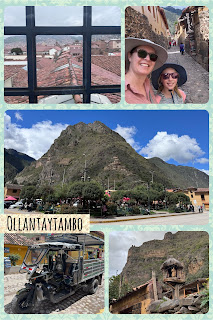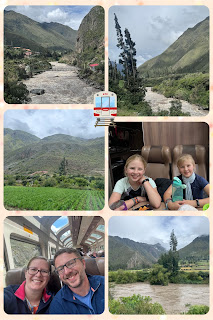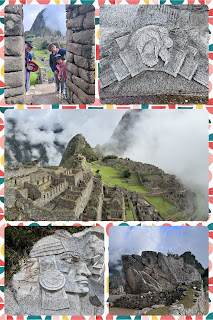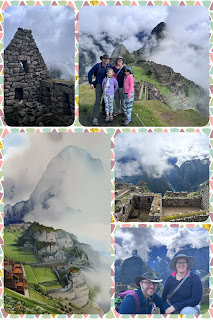On the way to Machu Picchu, we stop in the little town of Ollantaytambo. This the town from which to best catch the train to Machu Picchu. And whilst in Ollantaytambo we went up Temple Hill, also known as ‘the Fortress’. It was never a military facility only a religious one, but with many terrances leading up to it, it does look impressive and very imposing. The main structure is the Sun Temple, an incomplete building which features the Wall of the Six Monoliths, and they are huge!How they managed to bring those huge slabs of rock up the mountain remains a mystery, especially without modern equipment. A very impressive feat! Actually, most of the temple complex was made up of superbly carved stones that perfectly fitted together. The view from the top was also spectacular, looking up and down the valley.
We had another cooking course in town for dinner one night. This time we learnt how to make vegetarian (peas, lima beans and carrots) stuffed hot pepper with a spicy peanut and cheese sauce, of course with more potatoes. There was a lot of chopping, with a bit of crying from the onions. It was a fun afternoon around a table, with some good company and a delicious supper.
As it is the Holy Week leading up to Easter, there are lots of festivities in the main square. And we were lucky enough to catch some regional traditional dancing, which was very different from what we saw on the islands of Lake Titicaca.
From Ollantaytambo, we took the train to Aguas Calientes, from which you head out to Machu Picchu. The train journey is along the river (Urubamba River) that runs down the valley. Shear rock on one side of the train and ledge down to the river with gushing water on the other side... Some stunning scenery along the way.
The town of Aguas Calientes, is a very touristy town, that can only be reached by either by train or on foot, via the Inca trail. The only vehicles in town are the buses that run up mountain to Machu Picchu, and some funny electric carts. It has a huge craft market, that sells very colourful textiles and souvenirs from Peru.
The day we went to Machu Picchu, we got up early to catch the bus (up a very VERY windy dirt track) and started walking the trail at around 7 am. We were a bit worried as when we left the hotel it was raining, and the clouds were covering the mountain tops. However, as we reached the main part the Inca town of Machu Picchu, the sun started to shine through the clouds and gave the whole experience a more mystical feel with the cloud shroud. It made for some very awesome pictures (once we waited for the throngs of tourist to move out of the way).
Machu Picchu is a 15th-century Inca citadel/town located at 2,430m above sea level and is often referred to as the "Lost City of the Incas". This is due to the town being abandoned, and hence “lost” to history, due to people dying out (via diseases that the Spaniard brought from Europe apparently). It was only rediscovered in 1908-1911 by an American explorer named Hiram Bingham III.
The meaning is Machu Picchu is “old mountain”, and of course right next to it is the “new mountain”. It was a town for the “Elite”, this is known due to stone houses. You could tell who was important by the size of the stones used (bigger = more important) and by the technique used (important people had their houses built without any mortar). The common people (the peasants) lived in either mud or wooden structures, in another town close by. The biodegradable nature of these structures mean they are no longer around. Inca towns were limited to around 1000 people, to foster a community and to also limit the impact on the environment. The Inca had a very strong connection to nature (Pachamama), and dedicated their temples to them (to the Sun, the Moon, the Earth, etc). Hence when they went to temples they would take their shoes off to be in direct contact with the earth. Most temples would be uncovered so that they could be closer to the sun/moon/stars. A very physical connection, while Pachatata (Father Earth) was more of a spiritual connection. There is a lot of duality within the Inca religion and belief system.
As we walked through the Machu Picchu, we saw how the homes were setup. They were basically one or two bedroom homes, each opening directly to the outside. Kitchen, dining areas, were all communal and shares with another 4-5 other households. Again, enforcing a community feel to their lifestyle. As with most towns, there was a square which functioned as central place for all festivities and celebrations, as well as for hosting the market for the town.
We were curious how Machu Picchu was built and by whom, especially since it was for the Elite of the Inca civilisation. The Inca’s did not have the concept of money (they bartered instead), but also had to pay taxes. These taxes were in the form of 2 months of “free labour” that each male over the age of 15 had perform each year. Some of this labour was to build towns or farm for the elite, but it was also to build and maintain the roads/trails, aqueducts and other infrastructure that would benefit the society as a whole.
It was also interesting to learn that the Incas would marry around the age of 20, and their process was slightly similar to what we found on the islands of Lake Titicaca. When a couple was interested in marrying, they would first have to live together for up to a year. If by the end of the year the man did not propose, then community would force them to decide to marry or not. To propose, the man would offer a pair of sandals (of course these had to be as fancy as possible - ie. expensive), and ask his wife to be “Will you walk in this life with me?”. If she accepted, then they would be married on the spot by the spiritual leaders, the shaman.
The trip to Machu Picchu was an incredible experience. With sad hearts we boarded the train back to Cusco, but also looking forward to our next part of the South American adventure.




























Comments
Post a Comment